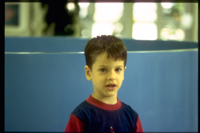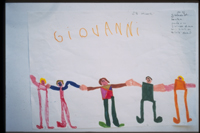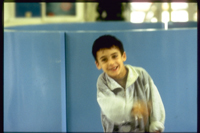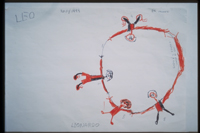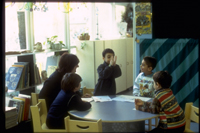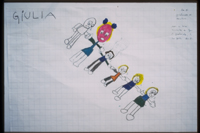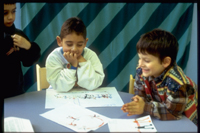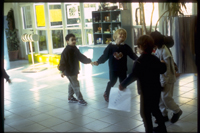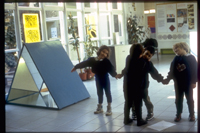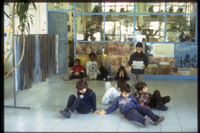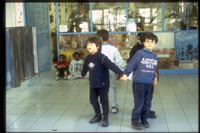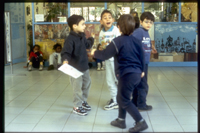The children play Ring-Around-The-Rosie, talk about "Ring-Around-The-Rosie," predict the way in which they can be represented graphically, and then draw them. We will begin by putting together the verbal predictions and the individual drawings of the three children who are the protagonists of the story.
Documentation Examples > Examples of documentation that is shared more widely
Ring-Around-The-Rosie
School: Municipality of Reggio Emilia
1. First Drawing
Giovanni: Drawing a Ring-around-the-Rosie is easy! Because you draw some kids with their faces in front and then... not all of them with their faces, but also with their backs.
Giovanni seems to have clear ideas about what to do: he identifies the need to draw children from various points of view.
This is the Ring-Around-The-Rosie that Giovanni drew after making a verbal prediction of the representation. He comments on his drawing as follows: I drew a different kind of Ring-around-the-Rosie, with the kids with their heads in front.
Giovanni seems to make light of his error by giving a definition of "difference" that can include many things, even a Ring-Around-The-Rosie in a straight line.
Leonardo: I think it's easy to draw a Ring-Around-The-Rosie of kids because you draw a round shape like this (he traces it in the air), then the kids... then... it's done.
To Leonardo, the circle seems to be the guiding shape of the whole representation.
Once his drawing is completed, to his great satisfaction, Leonardo comments on it like this: Look what a great Ring-Around-The-Rosie! There's an arm here that's a little long; but otherwise it wouldn't reach!
In his drawing, Leonardo followed the schema that he had previously hypothesized verbally, drawing the circle first and then drawing four children on it.
When the children have completed their drawings, they are called on in groups to comment on their own Ring-Around-The-Rosie and those of the other members of their group. The groups are formed partly following the children's own suggestions and partly under the guidance of the teachers, who take into account the different strategies adopted by the children, both in the way they define the problems and in the search for different ways to resolve them.
The children begin to make their first comments, and then turn to Giulia: What about your drawing, Giulia? Will you show it to us?
Giulia (leaning her elbows and forearms on her drawing): No, okay, I know I got it wrong, I made a line, not a circle of children... it's hard!
The teacher's assessment is not as harsh as Giulia's, since in her drawing she set the children on a diagonal line across the page. From this layout we glean that she has been asking herself some intelligent questions and playing with ideas intelligently to convey the spatial situation of the Ring-Around-The-Rosie through her drawing. The teacher elicits comments on all the drawings.
Giulia: Well, they're not really Ring-around-the-Rosie but we did the best we could.
Giovanni: (laughing) Why don't we all stand like the kids in our drawings?
Giovanni's idea, which turns around the usual approach of interpreting reality through drawing, appears to us to be excellent; in this way, even the trip-ups of the representation can become elements of fun in order to advance thinking. It is an intelligent idea, brimming with questions, trials, and fun. The teachers pick up the idea and later re-launch it to all the children in the class, group by group.
Here we will follow only the work of two of the children we have already introduced.
Giulia: I want six kids because I drew six!
She examines her drawing at length and appears to be wondering how to get her classmates to stand in the strange diagonal position she has drawn.
She solves the problem by positioning the children's heads in a diagonal position with her hands. She also carefully positions her friends' hands and feet in order to make them accurately match the Ring-Around-The-Rosie she drew. Open your arms out, your hands aren't exactly holding each other tight, they're only touching.
Leonardo also calls out the number of classmates he has drawn in his picture (four). Lying down in the position drawn by Leonardo sets off an outburst of general hilarity.
Giovanni says: In Leonardo's picture he's looking at the kids from above, he's up there and we're down here lying on the floor.
We are going to see how Leonardo mentally stores the point of view used by Giovanni to interpret the situation, and uses it on a later occasion. Very often it is other people who, with their comments and interpretations, make us more conscious of the choices we make.
Leonardo: To make it into a real Ring-Around-The-Rosie we need everyone to stand up!
One of the most amusing moments is when the children move from lying down to standing up, as requested by Leonardo. The children do stand up, but they find, themselves with their shoulders facing each other in an improbable Ring-Around-The-Rosie back to front.
Leonardo: No, this isn't right. This Ring-Around-The-Rosie is kind of small and a little silly. The backs are turned toward the other backs, but the bodies have to face the other bodies.
Giulia: But the picture is always still. How can you make the Ring-Around-The-Rosie so that it shows?
Giovanni: Come on guys, let's try to do a Ring-Around-The-Rosie for Giulia, then we can see what we look like, like a photo!
Through his words, Giovanni seems to be positioning himself from an external point of view in order to get an overall view of the situation. It is important to know how to move through space with your thoughts.
Giovanni: There are some kids that you only see their backs. I can see Giulia's back; she's looking at Giorgio's face; Leonardo's side (profile), who's looking at Matteo's face.
Some statements can be seen as generators of thoughts that enlighten the mind. Giovanni's is one of these: backs and fronts, then profiles and fronts of human figures who are looking at each other and are positioned in a relational space. This relational situation will become an important aspect of the experience that other children will take up and use as guidance.

